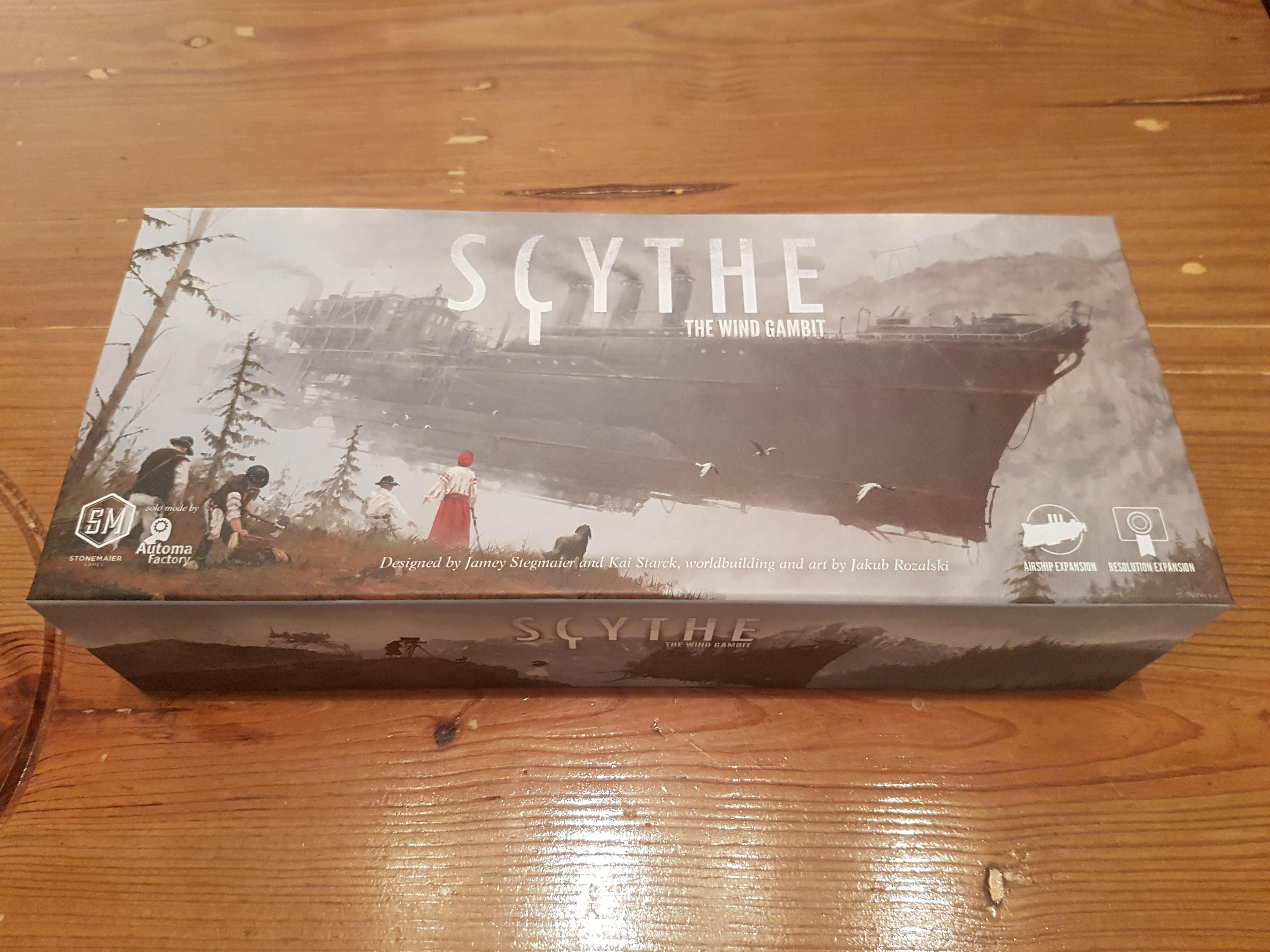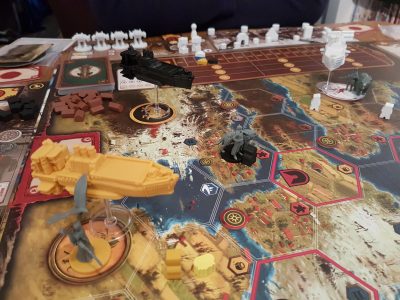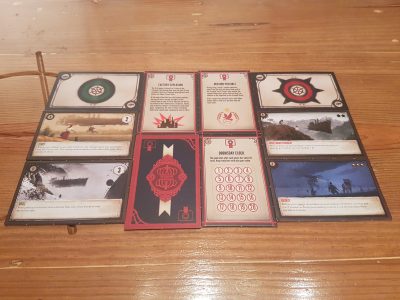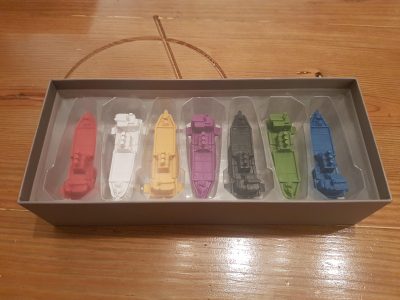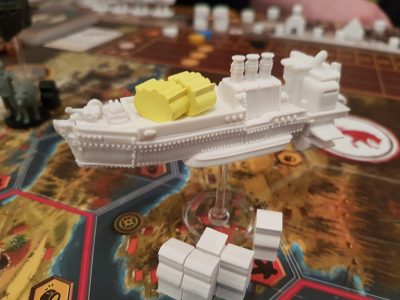The Wind Gambit is the second in a trilogy in expansions for the highly rated alternative history, area control, strategy game Scythe. Designed by Kai Starck and Jamey Stegmaier, and published by Stonemaier Games, this expansion once again features artwork from the universe created by artist Jakub Rozalski. This expansion works seamlessly with both the base game on its own or in conjunction with the Invaders From Afar expansion, allowing for 1 to 7 players to join in the action. The Wind Gambit expansion adds in two separate modules that can be included: airships and resolution tiles. However, do these modules add to the experience or ruin the celebrated gameplay? Let’s find out!
The story goes that the great minds of Eastern Europa have put their heads together and come up with steam-driven airships. Naturally, each faction wants to utilize this new technology to their empire’s advantage, and thus they appear on the battlefield. At the start of the game, unlike with Mechs, players start with an airship on their home base alongside their leader.
Making the airships slightly different from one game to another are 16 airship tiles included in the box: broken down into two groups of passive and aggressive tiles. Two tiles, 1 of each type, is randomly selected at the offset of the game, which give abilities to the airships, as well as movement values. By default, the same two tiles apply to all airships, though there is a variant where all players get their own unique passive and aggressive airship tiles. To limit the rule/ability questioning and for the sake of perceivable balance I’ve found it best to stick with the default two tiles for all ruleset.
The airship tiles change how the unit interacts with the board and various other factors. By default airships never grant territorial control nor do they enter combat, floating high above the action. The red backed aggressive tiles come with either symbols for three resources or two workers, denoting which of the two the airship can carry that game. The three tiles with resources enable you to load cargo onto the airship and then spend it when combat occurs on the hex below the airship. For example, Bombard allows the airship’s owner to pay 1/2/3 resources from the airship to reduce and enemies power by 1/3/5, not a shabby return. When the cards feature the worker symbol it is less about what they do to directly impact combat and more about being able to fly workers around quickly from one location to another.
This movement is dictated in some part by the green backed defensive airship tile it is paired with. The majority indicate that the airships, which are not included as a plastic miniature for the sake of mech bonuses, can move 2 hexagons per movement. This being said, there are two tiles, Drill and Safe Haven, that mean airships have 3 hex movement and a single tile, Hero, that means it only has 1 hex movement. The defensive tile bonuses directly affect actions taken on the airships hexagon, so moving it around to gain more benefits becomes a viable tactic. Interestingly, some of these seem to align with faction abilities, such as Ferry and Negotiate. The prior allows the airship to act as a ferry for units to move onto and off a lake, while the latter enables players take choose an additional encounter outcome. These will change things up somewhat for the Nordic and Polania factions respectively, as they are similar to one of their faction abilities.
Airships aren’t the only thing The Wind Gambit expansion adds into Scythe, Resolution tiles are also added into the mix. This second module can be included in any game with or without the airships, so players can customise the game as they see fit. Like with the two types of airship tiles there are 8 resolution tiles included in the box. These also come in multiple types, though the line between them is much more of a grey area, with no official distinction. Effectively, some of the tiles effect just how the game ends, adding a new condition alongside a 6th Triumph star that will also trigger the end of the game. A great example of this is Doomsday Clock which removes the 6th star finish completely, replacing it with a 20 round countdown.
Some of the resolution tiles will add an effect that triggers when the game ends. A prime example of this is the awesome Factory Explosion, which sees the game end two turns after a player adds a 5/6 star to the Triumph Track. After this the factory and surrounding adjacent hexagons explode sending any units back to their home base, but providing +1 popularity per unit. Not only has this ending allowed me to sneak a win by just entering the top tier of the popularity tracker it also makes spending popularity and positioning more important during the game.
The last type of resolution tiles not only add an end game trigger but add a new rule into play. Spoils of War is one of these cards, which awards a player with $5 whenever they are the first to place a star on a category on the Triumph Track, with the game ending whenever anyone has over $40. This tile makes money freer flowing compared to the base game, so actions that players often have to debate if it’s worth paying for are taken more often, using this gifted money.
A lot of these tiles sound like they won’t change the gameplay too much. While I wouldn’t go as far to say it’s too much, they do make every game feel unique. Not only from the way the game can end via a different condition, as games can end sooner players have to adapt their strategies away from building up slowly over time to rushing specific objectives. Taking Factory Explosion as an example, players that rush the centre of the board getting the factory and surround area locked down early on, can command a strong position over the others. Conversely, they might become an instant target from all other players. This can result in much more combat than in a regular game of Scythe, despite the resolution tile not mentioning combat. Old strategies are by no means redundant, though it will mean that players have to adapt slightly each game, to best optimise their efforts.
As expected of Stonemaier Games they have thought ahead for all owners of Scythe, with airship miniatures included for all 7 factions and tweaks for Automa rules. As the airships have room for workers/resources it is hard to describe them as a “mini” and this is actually the first issue. As they float above the hexagons, on stands, the airships can significantly block the view of the board for players. While it isn’t always a necessity to see exactly what is going on, players will often want to know, especially with the new ways the game can be ended.
At the same time the board looks more epic than ever before, something I didn’t think was possible, as you have airships towering over the workers, heroes and mechs. Interestingly due to their size airships’ presence on the board is almost more of a visual deterrent than mechs. This is despite the fact that they often don’t affect combat and they don’t contribute to territory control. There’s something about that floating block of plastic that makes you stay away. Like with mechs their main purpose is not to engage in mass combat but to ferry workers and resources around the board, making movement that bit more open.
The airships are solidly built, with the same level of detail as the mech miniatures. Aside from the quality of the airships it is disappointing that the 7 faction airships are all identical in design. Their colours instantly split them apart, making it extremely easy to see whose is whose, yet with unique mech miniatures and player hero miniatures it is a shame that same level of uniqueness was not further celebrated. As far as the rest of the production quality goes, the tiles are thick and chunky, fitting the quality of the base game – featuring more of that glorious artwork the base game is known for.
Airships may adorn the artwork of The Wind Gambit’s box but resolution tiles actually effect the game more. This thought was compounded after a game where I completely ignored the airship, leaving it on my home base, I was still able to win despite similar level opponents utilizing airships for their powers and movement buffs. They might not be as visually epic but the resolution tiles adds a wave of freshness to the experience. With 8 of these resolution tiles included in the expansion box, using one per game you’ll have to play many hours before you even see the same one coming back up.
For playing with new players I would be hesitant to add either module from this expansion into the experience. Neither is exactly complicated, though there is already enough going on for those jumping into the game for the first time to pick up. This is less about Scythe being regarded as a complex game and more about allowing players to easily recognise the logical steps, without layering more rules on top. After a player has participated in a game, they’ll be in a much better place to have airships included, with a couple of games under their belt being a better time to add a resolution tile into the mix
This expansion won’t change anyone’s mind on Scythe. Someone that found the base game didn’t click with them won’t suddenly find their issues have been fixed. Conversely, this means for gamers whom have thoroughly enjoyed the game to date it doesn’t break the core gameplay. In similar fashion to the units of the base game, the airships, despite sounding and looking like they’ll fire down huge bombardments, are extremely passive units.
Regardless of them being the biggest thing in the box the airships have less of an impact than I had anticipated, especially when unable to carry workers or compared to the resolution tiles. If you’ve got to the stage where games of Scythe are starting to take similar trends then this expansion is for you, as the resolution tiles do shake up the way games end. Most will probably not fall into this category, so while the resolution tiles may sound good their true impact may almost be lost. If you’re looking for something to add to your Scythe experience, The Wind Gambit will certainly do this, but you will have to weigh this up against the cost and amount of times the game hits the table for your group.
[Editor’s Note: Scythe: The Wind Gambit was provided to us by Asmodee UK for review purposes. The game is currently available on 365 Games for £24.99. It is also available from local UK board game stores, find your local store here]

